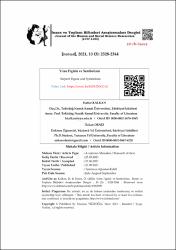| dc.contributor.author | Kalkan, Hatice | |
| dc.contributor.author | Deniz, Özkan | |
| dc.date.accessioned | 2022-05-11T14:28:21Z | |
| dc.date.available | 2022-05-11T14:28:21Z | |
| dc.date.issued | 2021 | |
| dc.identifier.issn | 2147-1185 | |
| dc.identifier.issn | 2147-1185 | |
| dc.identifier.uri | https://app.trdizin.gov.tr/makale/TkRRNU56RTNOdz09 | |
| dc.identifier.uri | https://hdl.handle.net/20.500.11776/6788 | |
| dc.description.abstract | İnsanoğlunun kültür ve inanç tarihçesinde ortak bir hafıza aktarımıylagünümüze dek ulaşan sembol grubu içinde hayvanlar önemli bir yertutmaktadır. Yılan bu açıdan belki de en fazla ve aynı zamanda karşıtlıklariçinde algılanan bir sembolizm öznesi olarak ortaya çıkmaktadır. Farklıdönem ve kültürlerin efsane, masal ve mitoslarında kendine yer bulan yılankavramsal açıdan iyi ve kötünün sıklıkla yer değiştirdiği bir niteliğesahiptir. Sözel ve yazılı gelenekteki bu karşıtlık, görsel aktarımlarda nasıl biryansımaya dönüşmektedir? Bu açıdan, antik materyal kültür kaynaklarıdayanağında yılanın ikonografik bir değerlendirmesinin yapılabilmesi,toplumsal algı değişkenlerine görsel kanıtlarla da bakılmasını sağlayacaktır.Yazılı kaynakların da referans oluşturduğu Yunan-Roma dönemine aitgörsel veriler değerlendirilirken, bu bağlamda, avcı-toplayıcı bir evreye aitolan Göbeklitepe insanlarının kabartmalarında öne çıkan en erken yılanfigürlerine de değinilmiştir. Şüphesiz yılan figürünün günümüzden on ikibin yıl önceye ait kabartmalarda dönemin insanı için ne anlama geldiği,varsayımlara dayalı olarak değerlendirilebilir. Bununla birlikte gizem,korkutuculuk, deri değiştirme gibi özellikleri, yılanın çağlar boyuncaneden bu denli sıklıkla görsel aktarımlarda yer bulduğu konusuna yanıtolabilir.Diğer yandan yazılı kaynakların devreye girmesiyle birlikte Sümer, Hitit veKlasik Hellen-Roma mitolojisinde yer bulan serpens-yılan, çok yönlü birmetafor ve sembolizm içeriğinde ve daha da zenginleşmiş görsel yorumlarlakarşılaşılan bir figüre dönüşür. Burada söz konusu bu sürecin yazılı vegörsel verilerle ortaya konulduğu bir çalışmanın sonuçları paylaşılmıştır.Ayrıca burada yılan figürünün ölü kültü ve yeraltı dünyası ile olan yakınilişkisi nedeniyle yeni bir öneri olarak tümülüs üzerlerinde dikilen ve fallostaşları olarak adlandırılan buluntuların yılan olabilme olasılığı içinde elealınması tartışmaya açılmıştır. Nitekim bu konudaki görüşler arasındabolluk ve bereket sembolleri olarak görülen fallos sembollerinin gömü veyamezar ikonografisinde başka örneklerle görünmüyor olması bu konuda birdayanak oluşturabilir. Diğer bir görüşe göre ise bu örnekler Anadolu anatanrıça idollerinden etkilenerek kullanıma girmiş olan mezar cippuslarıdır.Yeterli ve tutarlı olasılıklarla ele alınmamış olduğu anlaşılan konunun ölükültü ve gömü gelenekleri açısından yeniden ele alınmasına ihtiyaç vardır. | en_US |
| dc.description.abstract | Animals occupy an extensive space among the symbol group which has survived as a part of the human culture and belief systems by means of collective memory. In this respect, the snake may be the most controversial and the most ubiquitous symbol perceived in contradictory terms. The serpent, which appears in legends, fairy tales and myths throughout different periods and cultures, embodies alternations of good and evil. How does this contradiction found in oral and written tradition translate into image in visual expression? An iconographic evaluation of the serpent symbol on the basis of ancient material and cultural resources will enable the social perception variables to be examined with visual evidence. In this respect the evaluation of visual data pertaining to the Greek -Roman period will also include reference to the earliest serpent symbols found in Göbeklitepe reliefs made by a hunter gatherer population. Undoubtedly, what the snake symbol in the reliefs made twelve thousand years ago meant for the people who made them can only be assumed. Yet, its properties like mysteriousness, eeriness, ability to shed skin may provide an answer as to why the serpent often found a place in visual narratives. On the other hand, the Serpens-snake symbol found in the written sources of the Sumerian, Hittite and classical Hellen-Roman mythology, assumes a multi-faceted metaphorical and symbolic content and is transformed into a figure with richer visual interpretations. In this article, we share the results of a study which presents this process of transformation of the snake figure with written and visual data. In this article, a proposal is put forward as to the discussion of possibility that the findings on tumuli previously considered as representations of phallus may in fact be representations of the snake figure due to the close relationship of the serpent with the cult of the dead and the underworld. As a matter of fact, the fact that there are no other examples of the phallus symbol in burial or tomb iconography constitutes a basis for proposal. According to another view, these symbols on tumuli were influenced by Anatolian mother goddess idols and thus came into use as grave cippus. It is understood that the issue of the findings on tumuli has not been dealt exhaustively and sufficiently and needs to be re-evaluated with reference to the cult of the dead and burial traditions. | en_US |
| dc.language.iso | tur | en_US |
| dc.rights | info:eu-repo/semantics/openAccess | en_US |
| dc.title | Yılan Figürü ve Sembolizm | en_US |
| dc.title.alternative | Serpent Figure and Symbolism | en_US |
| dc.type | article | en_US |
| dc.relation.ispartof | İnsan ve Toplum Bilimleri Araştırmaları Dergisi | en_US |
| dc.department | Fakülteler, Fen Edebiyat Fakültesi, Arkeoloji Bölümü | en_US |
| dc.identifier.volume | 10 | en_US |
| dc.identifier.issue | 3 | en_US |
| dc.identifier.startpage | 2328 | en_US |
| dc.identifier.endpage | 2344 | en_US |
| dc.institutionauthor | Kalkan, Hatice | |
| dc.identifier.trdizinid | TkRRNU56RTNOdz09 | en_US |



















